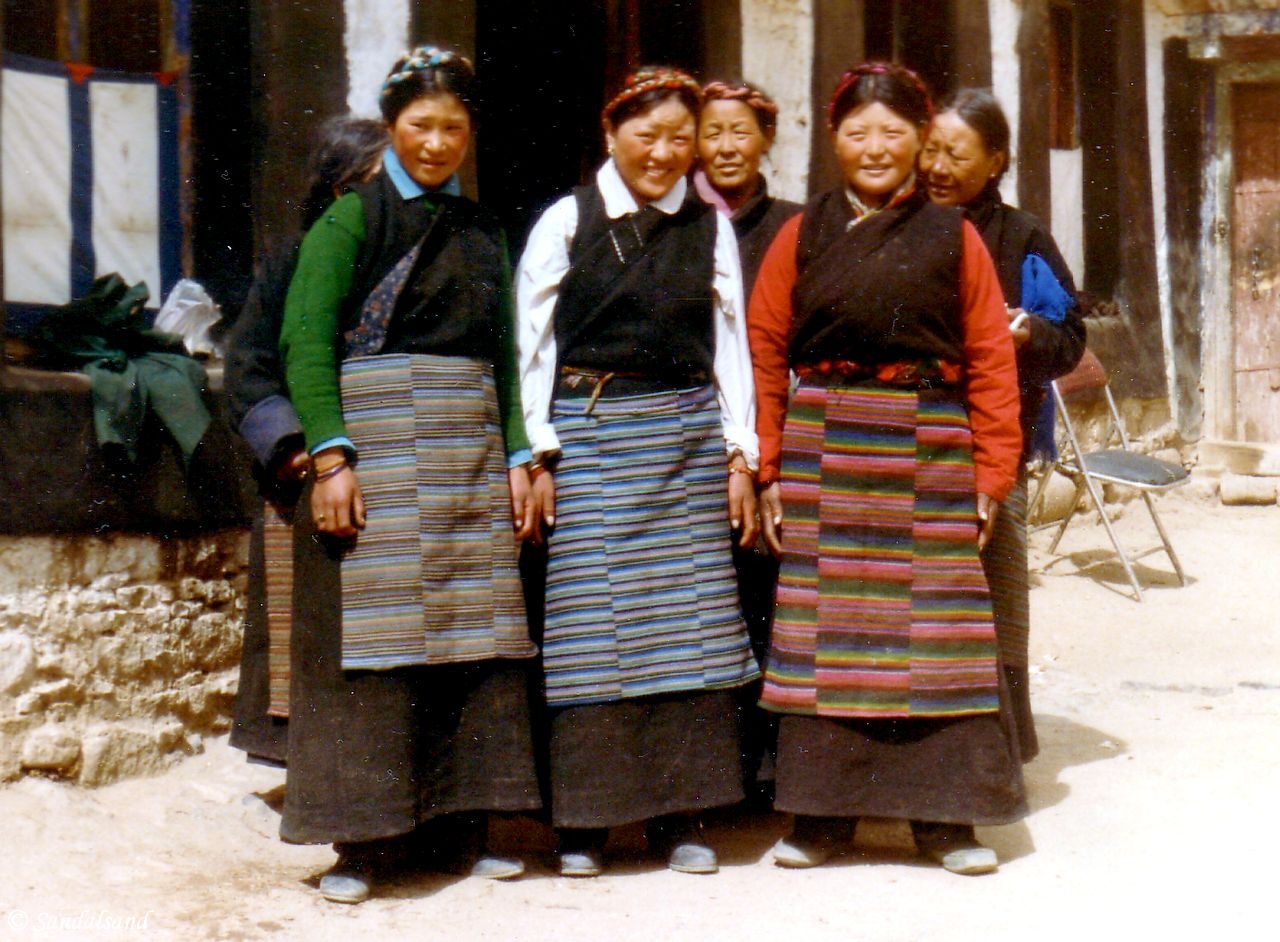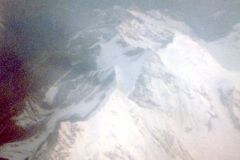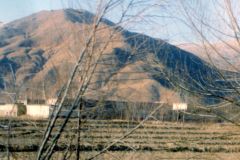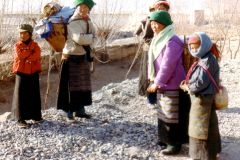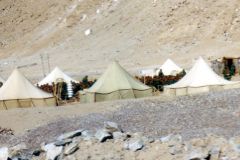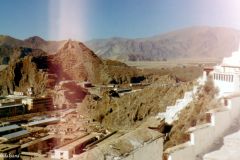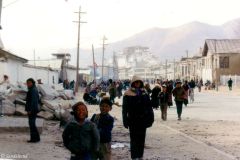11 days on top of the world, in Tibet, a few months after it opened up for individual travellers. This post is about the two first two days and a letter home.
This article is part of a diary based travelogue from a six month journey in 1985 to several countries in East and South East Asia: Japan, Taiwan, China, Philippines, Singapore, Malaysia and Thailand.
Saturday 23.2.1985, Lhasa
Getting there
The plane from Chengdu to Lhasa took off shortly before seven in the morning. The flight took a couple of hours. We crossed snow-covered mountains and it was all very interesting.
The airport was in a wide valley with a wide river running by and was surrounded by tall, naked desert mountains. There was no vegetation at all.
We boarded some old rickety buses which would bring us to Lhasa, a trip that took four hours. Others were not that lucky – I later spoke to someone who had spent the twice as many hours on the bus. The “road” went through a stone desert landscape and was made of crushed stone and dust. We passed Yak-animals, sheep, cows and very interesting Tibetans with their unique clothing. They seemed very robust.
We could see Dalai Lama’s Potala Palace high up on a cliff in the middle of a broad, long-stretched valley long before we actually arrived. The castle dominates the city, in every aspect of the word.
- Tibetan hostel (can’t remember the name). First street south of CAAC where the bus stops; turn left, right hand side. Signposted. We walked for half an hour. There is no public transportation in Lhasa apart from a couple of buses which are highly irregular and rare. Dormitory for 5Y, primitive but plenty of bedding as the nights can get pretty cold. It was nice and preferred compared to the other two guest-houses; a Chinese and a Sino-Tibetan (Snow Land had recently opened and wasn’t bad).
First impressions
The sun was scorching from a beautiful, blue sky and I took off my shirt for a few hours that afternoon. As mentioned the nights get cold however. We also had a short walk in the old Tibetan part of the city with small, white-chalked houses along narrow alleys.
The people – the Tibetans – are dressed in leather/fur-clothes with lots of jewellery. They are more tanned, stouter and with – in the eyes of most foreigners – better looks than the Han-Chinese. Exotic – was my first reaction.
We found a Muslim noodle-café and had a lot of tea and a bowl of noodles each. Thanks to Colleen’s knowledge of the Chinese language and our nice conduct (!) we became good friends with the proprietors and the other guests. (We got our meal cheaper than the other white people who dropped in.)
Everywhere outside we were spoken to by children with their “hello” and by adults eager to sell their jewellery etc.
Virtually everyone keeps staring at us, and we naturally stare back. We are as strangers to them as vice versa. They seem very innocent and naïve. Yet, before the flood of mass tourism comes in not so many months.
The air is thin and the weather is dry so we have to take it easy, and drink a lot. I have felt a bit unwell since I came, but it will probably pass after a couple days.
Sunday 24.2.1985, Lhasa
I did little today. I walked around in the side streets and picked up my baggage at the CAAC. It rarely arrives in Lhasa the same day as the travellers!
We ate noodles at the same place as yesterday and relaxed at the hostel afterwards.
Lhasa is a fine place to just cool it for a while. Everything seems so relaxed and relaxing.
Letter to my family
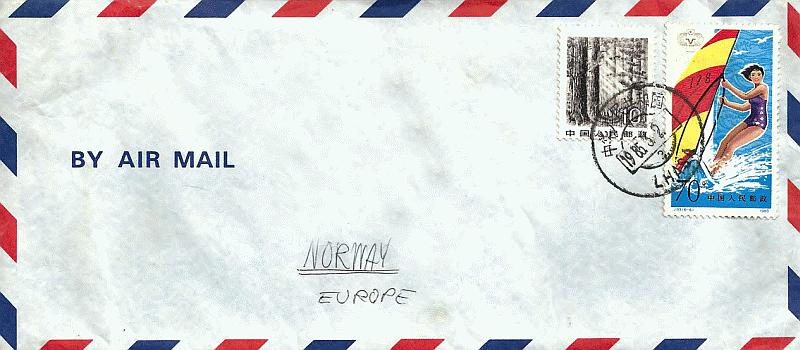
Lhasa, Tibet, 24. February 1985
Well, then I came here after all, and it is truly a fantastic place.
I should have written before but I wanted to wait until arrived. Unfortunately the journey up here was postponed a few days and the letter had to wait. But here it is!
Let me begin in Hong Kong and tell “all” about my initial two weeks in China. I took the night ferry from Hong Kong to Canton together with two Danes. Actually, I had in mind to stay there a couple of days but it ended up with me taking the train onwards the same afternoon.
I had to wait at the railway station for two hours before getting a ticket, and it was not even I who bought it. You see that I was approached by a Chinese who asked where I was heading. Guilin, I said. He was too, and it ended with him buying the ticket for me at a cheaper cost than I – a tourist – would get. Tourists must pay for everything at a higher cost than the Chinese themselves. They apparently believe that all foreigners are rich.
.
The two of us walked around in the city (Canton) a couple of hours and sat down on the train. We had bought “hard sleeper” tickets; that is a hard bunk for sleeping. The trains are divided into several classes in “classless” China: Hard seat, hard sleeper, soft seat, and soft sleeper. The prices vary.
The train journey took about 24 hours so a bed was necessary. I had a quite pleasant time on the train – the Chinese are nice and curious – so the hours passed considerably faster than expected.
Guilin is a popular tourist destination, a bit too popular and the place is not extremely exciting. But by all means, for me who hasn’t seen China before it was really interesting. I rented a bicycle, not exactly a scarce commodity in China. (Apart from this it does not seem to me that China – a developing country – really lacks anything of the daily necessities, stereo sets and TV included.)
I took a boat trip down a river and saw the original scenery from all the Chinese paintings with tall, tipped karst (limestone) mountains; very good.
.
Then I decided to move on; this time to Kunming further to the west. The English speaking Chinese bought a ticket for me, but only hard seat. The train ride was scheduled to last 33 hours, so this was a genuine crisis. It turned out that seven other “big-noses” were in the same boat (or train!). So after a few hours of waiting, asking and foreigner-friendly conductors we all had received hard sleepers. The train ride was saved.
In Kunming I joined an Australian, an Irishman and a girl from Canada and checked into a hotel. The selection of hotels in China is limited for tourists, but the places that are available are very good; this one too.
The next days would alter much of my China plans. I heard that Tibet recently had been opened to individual travellers (not only tour groups at sky high prices) so Pat (Ireland), Colleen (Canada) and I decided to travel up there.
We were told that there would be a festival in Lhasa, the capital of Tibet, a few days later so we left Kunming with a plane to Chengdu already a couple of days later. But in Chengdu it turned out that there was no plane to Lhasa until after New Year; that is on Saturday the 23rd. We then had an unappreciated long stay in a not too inspiring city.
.
Actually Chinese cities are not much to write about, the ones I have seen. Kunming was however good. What fascinate are the people. Most Chinese are so-called Han Chinese, the group we usually associate with China. But Kunming and the surrounding province are packed with minority groups and it was incredibly exciting to wander around just studying them and their colourful clothing.
Not all Chinese walk around in Mao-uniforms, they are also trying to wear some coloured clothes. But as you know, if you want something hard enough you can make it, and the colours do get a bit too sharp and weird.
It is by the way incredible how much the Chinese have been Westernised the last five years or so. Even in the most humble cabin you find a TV set and similar. The Disco-music also catches on here: Seven years old Boney M tunes are heard everywhere. They’re trying as hard as they can, but are not always succeeding.
Just listen: Pat, Colleen and I were on Wednesday invited to the hotel room by some Chinese. We entertained each other with songs and guitar play. The top came when C played Bob Dylan’s “Blowin’ in the Wind” and one of them shouted “disco”, jumped up and started to twist vigorously to this easy-going song.
.
I mentioned New Year. Wednesday was the Chinese New Year’s Eve and we are now in the year of the Ox. For several days we have been entertained and we have enter-tained the Chinese with fireworks and of course lots of small and large Chinese crack-ers. There are bangs in the streets all day long.
Food in China is good, but no bread or milk. C and I went to a restaurant in Kunming we knew was serving hot dinners, but not as hot as this! First they came with a pot with glowing pieces of coal inside, then a pot with obviously hot sauce which was put to boil on top of the other. It became quite pleasant, even in this typical unclean Chinese restaurant. In the sauce we cooked ourselves some strips of meat, vegetables and a few things I really don’t know what are. The meal was good – really – but too strong. It was nevertheless a very interesting experience and it showed that the Chinese kitchen is more than we get served at Chinese restaurants at home.
Moreover, spitting is very common here. I no longer become surprised when a Chinese in front of my on the street stops, harks, and leans forward letting his drool slowly drip to the ground. The same is the case of blowing ones nose in the hand and the fact that all Chinese men are smokers.
.
I mentioned that they recently had opened Lhasa to foreigners. You actually have to have a special permit to visit most cities here. Many are totally closed, even though illegal visits are not completely impossible. I’m intending to go to such a completely closed city from Lhasa. Two days on a bus across wild mountain areas and incredibly bad roads. The reason I want it is that I like the challenge and particularly because the plane ticket one way to Chengdu is more than 110 USD, and it is far too expensive to fly both ways. Travelling overland to Tibet is prohibited, apart from Nepal (recently), but I am not going there until later.
The flight into Lhasa was very thrilling, how often does one fly over mountain areas on the edges of the Himalayas? The four hour bus trip from the airport into Lhasa was equally exciting. A dreadful bus on miserable roads made the ride very bumpy, not eased by the whirling dust being sucked into the bus. We passed by Yak-animals, sheep, donkeys and Tibetans in colourful and exciting clothes, while driving through a close to stone desert that never seemed to come to an end.
.
The temperature is at 10 below zero at night, but the days get hot as the sun heats up from a clear, blue sky. Lhasa is surrounded by mountains, without snow or vegetation. It is situated at an altitude of 3500 metres above sea level I think, and everyone must take it easy the first days to avoid altitude sickness in the thin air. In addition we must – because of the dry air – drink very much liquid to avoid dehydrating the body. Certainly we must only drink boiled water, so we drink a lot of tea.
I came here yesterday and have of course not been able to see much yet. But what we’ve seen is top. The town is not very big and the dominant feature is the Potala Palace of Dalai Lama. It towers on a huge cliff in the middle of the valley and is easily seen from everywhere. We are going there tomorrow.
The Tibetans are very smiling, friendly and innocent. They are not used to tourists yet, although they keep coming up to us eager to sell their beautiful jewellery etc. And that they have in abundance. These people are tanned, rough and handsome, and it is indescribably exciting to walk around in the market and in the small back streets to study them and their doings.
I will spend at least a week here, but I’m not sure when I will have the opportunity to write home again. We’ll see.
Next letter: Xining
Read more
The introduction to this journey to East and South East Asia.
Previous chapter: Sichuan: Hot food, exciting street life and a stone forest in Kunming. New Year’s celebrations and pop music in Chengdu. And a drastic change of plans.
Next chapter: The story from my days in Tibet continues here with the bulk of the stay.

